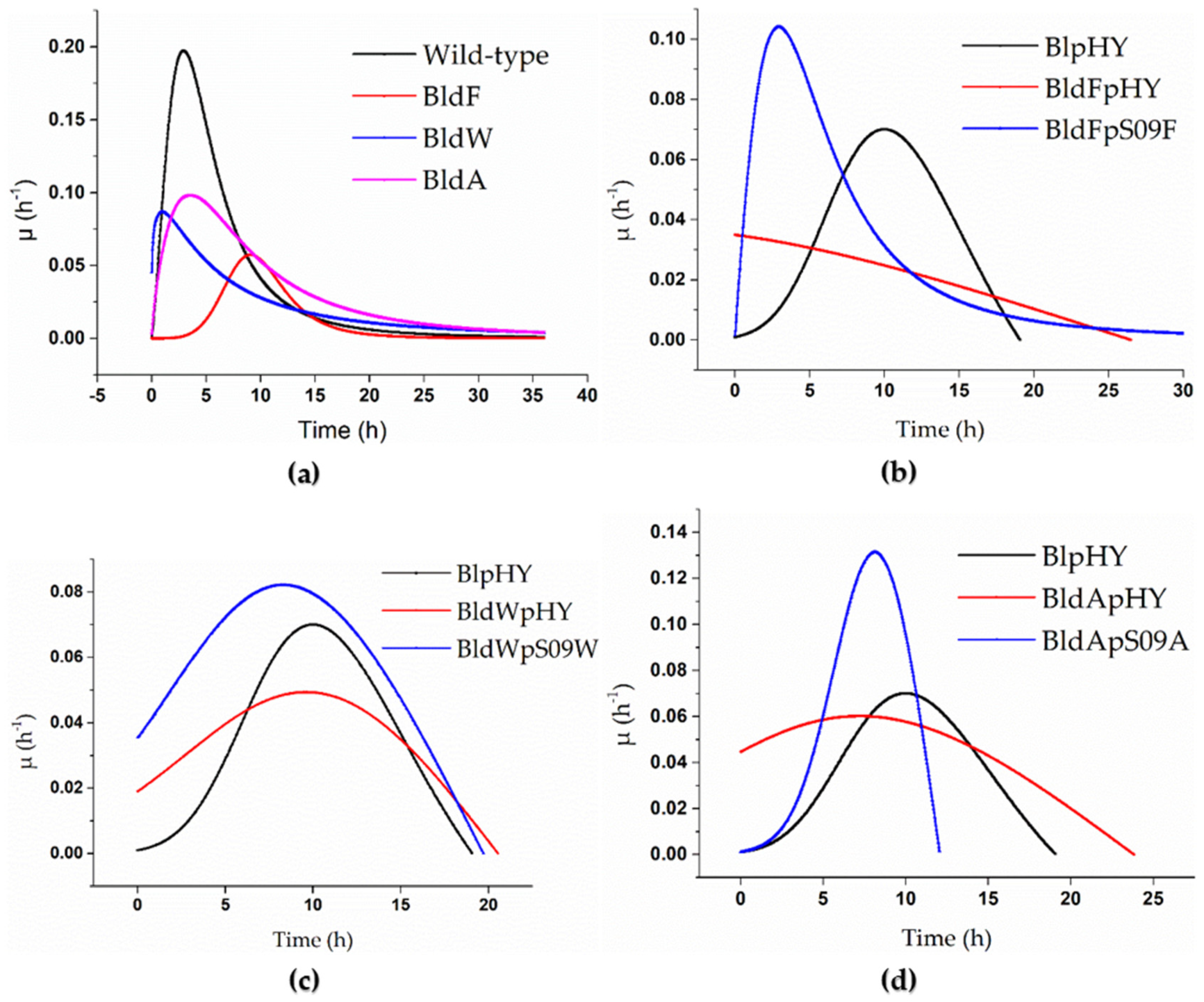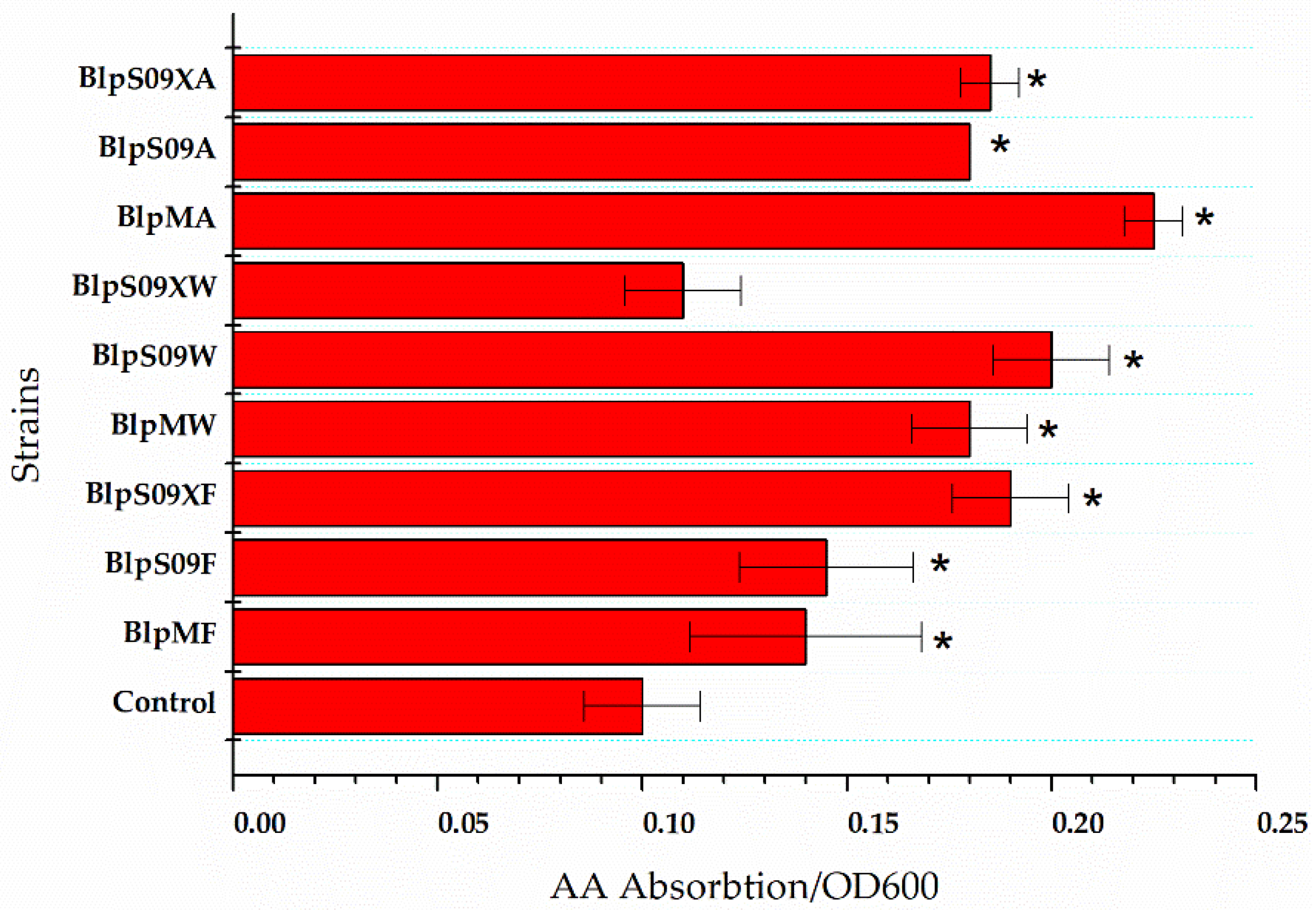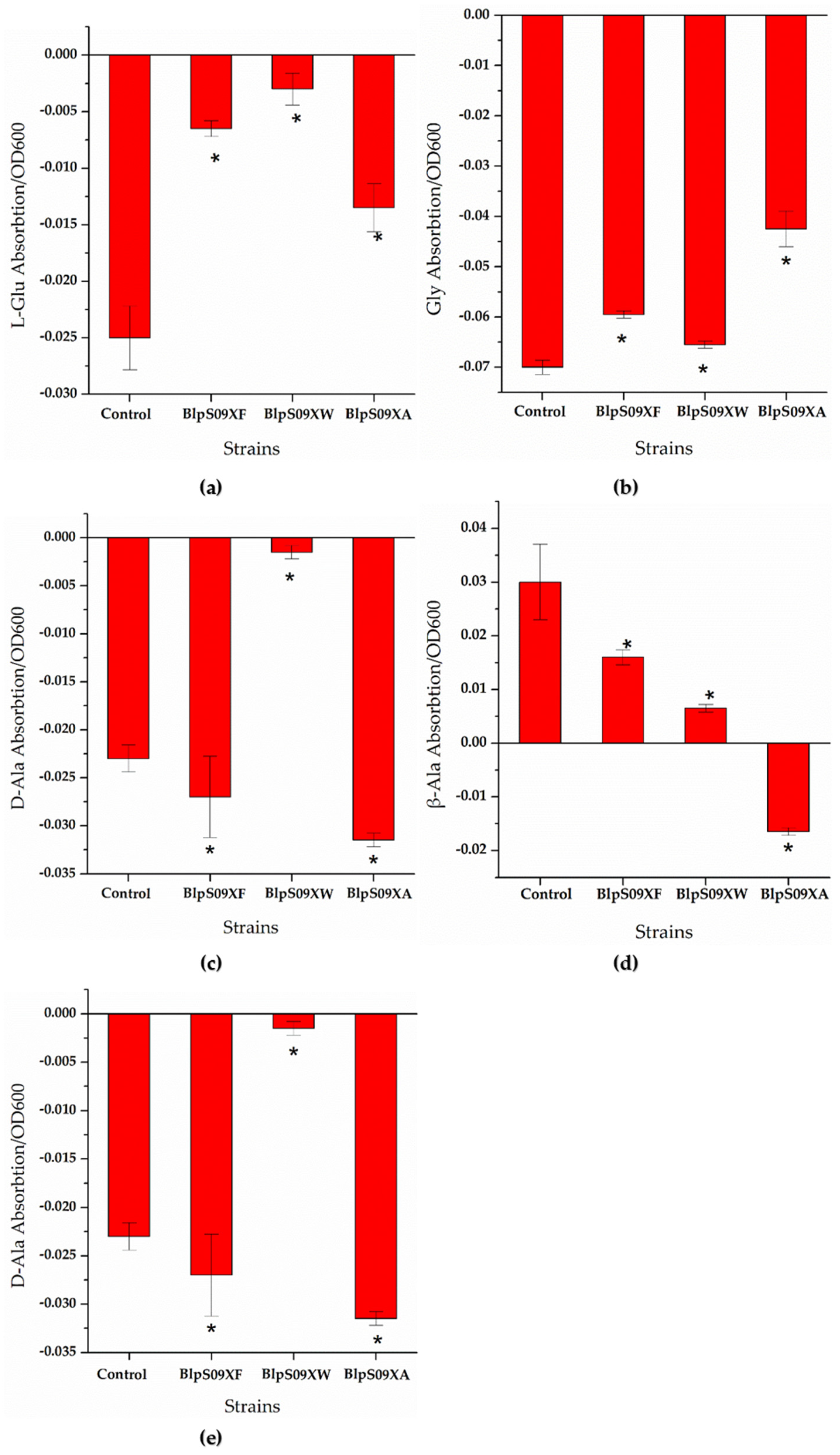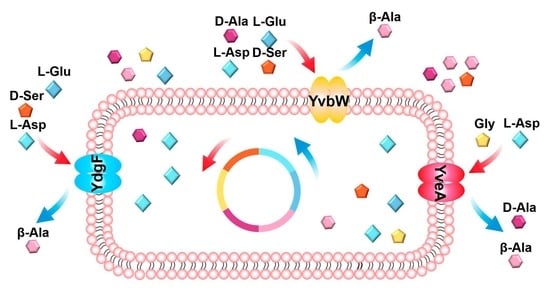Functional Characterization of Transporters for L-Aspartate in Bacillus licheniformis
Abstract
1. Introduction
2. Materials and Methods
2.1. Bacterial Strains, Plasmids, and Growth Conditions
2.2. Method of Gene Knockout in Bacillus licheniformis
2.3. Method of Cell Density Determination
2.4. Method of Whole-Cell Catalyst
2.5. HPLC
3. Results
3.1. Construction of Plasmids and Strains
3.2. Effects of Transport Protein Expression Changes on Strain Growth in a Minimal Medium with Free L-Asp as the Sole Carbon and Nitrogen Source
3.2.1. Growth Curves of Single-Gene Knockout Strains in a Minimal Medium with Free L-Asp as the Only Carbon and Nitrogen Source
3.2.2. Growth Curves of Single-Knockout Strains Supplemented with Genes Expressing Corresponding Transporters in a Minimal Medium with Free L-Asp as the Only Carbon and Nitrogen Source
3.3. Effect of Strains Overexpressing Amino Acid Permease Gene on L-Asp Absorption
3.4. Effects of the Absence of Amino Acid Permease Genes on L-Asp Absorption
3.5. Effects of the Three Transport proteins on the Transportation of Other Amino Acids by Bacillus licheniformis
4. Discussion
Supplementary Materials
Author Contributions
Funding
Institutional Review Board Statement
Informed Consent Statement
Conflicts of Interest
References
- Park, J.H.; Lee, K.H.; Kim, T.Y.; Lee, S.Y. Metabolic engineering of Escherichia coli for the production of L-valine based on transcriptome analysis and in silico gene knockout simulation. Proc. Natl. Acad. Sci. USA 2007, 104, 7797–7802. [Google Scholar] [CrossRef] [PubMed]
- Zakataeva, N.P.; Aleshin, V.V.; Tokmakova, I.L.; Troshin, P.V.; Livshits, V.A. The novel transmembrane Escherichia coli proteins involved in the amino acid efflux. FEBS Lett. 1999, 452, 228–232. [Google Scholar] [CrossRef]
- Trötschel, C.; Deutenberg, D.; Bathe, B.; Burkovski, A.; Krämer, R. Characterization of Methionine Export in Corynebacterium glutamicum. J. Bacteriol. 2005, 187, 3786–3794. [Google Scholar] [CrossRef] [PubMed]
- Shimizu, H.; Hirasawa, T. Regulation and Metabolic Engineering. In Amino Acid Biosynthesis~Pathways, Regulation and Metabolic Engineering; Wendisch, V.F., Ed.; Springer: Berlin/Heidelberg, Germany, 2007; pp. 1–38. [Google Scholar]
- Radmacher, E.; Stansen, K.C.; Besra, G.; Alderwick, L.; Maughan, W.N.; Hollweg, G.; Sahm, H.; Wendisch, V.F.; Eggeling, L. Ethambutol, a cell wall inhibitor of Mycobacterium tuberculosis, elicits l-glutamate efflux of Corynebacterium glutamicum. Microbiology 2005, 151, 1359–1368. [Google Scholar] [CrossRef]
- Park, S.; Imlay, J.A. High Levels of Intracellular Cysteine Promote Oxidative DNA Damage by Driving the Fenton Reaction. J. Bacteriol. 2003, 185, 1942–1950. [Google Scholar] [CrossRef]
- Vrljic, M.; Sahm, H.; Eggeling, L. A new type of transporter with a new type of cellular function: L-lysine export from Corynebacterium glutamicum. Mol. Microbiol. 1996, 22, 815–826. [Google Scholar] [CrossRef]
- BRÖER, S.; KRÄMER, R. Lysine excretion by Corynebacterium glutamicum. Eur. J. Biochem. 1991, 202, 137–143. [Google Scholar] [CrossRef]
- Liu, Q.; Liang, Y.; Zhang, Y.; Shang, X.; Liu, S.; Wen, J.; Wen, T. YjeH Is a Novel Exporter of l -Methionine and Branched-Chain Amino Acids in Escherichia coli. Appl. Environ. Microbiol. 2015, 81, 7753–7766. [Google Scholar] [CrossRef]
- Den Hengst, C.D.; Groeneveld, M.; Kuipers, O.P.; Kok, J. Identification and functional characterization of the Lactococcus lactis CodY-regulated branched-chain amino acid permease BcaP (CtrA). J. Bacteriol. 2006, 188, 3280–3289. [Google Scholar] [CrossRef] [PubMed]
- Belitsky, B.R. Role of Branched-Chain Amino Acid Transport in Bacillus subtilis CodY Activity. J. Bacteriol. 2015, 197, 1330–1338. [Google Scholar] [CrossRef]
- Ihara, K.; Sato, K.; Hori, H.; Makino, Y.; Shigenobu, S.; Ando, T.; Isogai, E.; Yoneyama, H. Expression of the alaE gene is positively regulated by the global regulator Lrp in response to intracellular accumulation of l -alanine in Escherichia coli. J. Biosci. Bioeng. 2017, 123, 444–450. [Google Scholar] [CrossRef] [PubMed]
- Kennerknecht, N.; Sahm, H.; Yen, M.R.; Patek, M.; Saier, M.H., Jr.; Eggeling, L. Export of L-isoleucine from Corynebacterium glutamicum: A two-gene-encoded member of a new translocator family. J. Bacteriol. 2002, 184, 3947–3956. [Google Scholar] [CrossRef]
- Kim, S.; Ihara, K.; Katsube, S.; Hori, H.; Ando, T.; Isogai, E.; Yoneyama, H. Characterization of the l -alanine exporter AlaE of Escherichia coli and its potential role in protecting cells from a toxic-level accumulation of l -alanine and its derivatives. Microbiology 2015, 4, 632–643. [Google Scholar] [CrossRef]
- Kruse, D.; Kramer, R.; Eggeling, L.; Rieping, M.; Pfefferle, W.; Tchieu, J.H.; Chung, Y.J.; Saier, M.H., Jr.; Burkovski, A. Influence of threonine exporters on threonine production in Escherichia coli. Appl. Microbiol. Biotechnol. 2002, 59, 205–210. [Google Scholar]
- Park, J.H.; Oh, J.E.; Lee, K.H.; Kim, J.Y.; Lee, S.Y. Rational design of Escherichia coli for L-isoleucine production. ACS Synth. Biol. 2012, 1, 532–540. [Google Scholar] [CrossRef]
- Dassler, T.; Maier, T.; Winterhalter, C.; Bock, A. Identification of a major facilitator protein from Escherichia coli involved in efflux of metabolites of the cysteine pathway. Mol. Microbiol. 2000, 36, 1101–1112. [Google Scholar] [CrossRef] [PubMed]
- Bellmann, A.; Vrljić, M.; Pátek, M.; Sahm, H.; Krämer, R.; Eggeling, L. Expression control and specificity of the basic amino acid exporter LysE of Corynebacterium glutamicum. Microbiology 2001, 147, 1765–1774. [Google Scholar] [CrossRef]
- Leuchtenberger, W.; Huthmacher, K.; Drauz, K. Biotechnological production of amino acids and derivatives: Current status and prospects. Appl. Microbiol. Biotechnol. 2005, 69, 1–8. [Google Scholar] [CrossRef] [PubMed]
- Chibata, I.; Tosa, T.; Sato, T. Continuous production of L-aspartic acid. Appl. Biochem. Biotechnol. 1986, 13, 231–240. [Google Scholar] [CrossRef]
- Chibata, I.; Tosa, T.; Sato, T. Immobilized aspartase-containing microbial cells: Preparation and enzymatic properties. Appl. Microbiol. 1974, 27, 878–885. [Google Scholar] [CrossRef]
- Song, C.W.; Lee, J.; Ko, Y.-S.; Lee, S.Y. Metabolic engineering of Escherichia coli for the production of 3-aminopropionic acid. Metab. Eng. 2015, 30, 121–129. [Google Scholar] [CrossRef]
- Feng, Z.; Zhang, J.; Chen, G.; Ge, Y.; Zhang, X.; Zhu, H. Extracellular Expression of L-Aspartate-α-Decarboxylase from Bacillus tequilensis and Its Application in the Biosynthesis of β-Alanine. Appl. Biochem. Biotechnol. 2019, 189, 273–283. [Google Scholar] [CrossRef]
- Lorca, G.; Winnen, B.; Saier, M.H., Jr. Identification of the l -Aspartate Transporter in Bacillus subtilis. J. Bacteriol. 2003, 185, 3218–3222. [Google Scholar] [CrossRef]
- Saier, J.; Milton, H. Families of transmembrane transporters selective for amino acids and their derivatives. The information presented in this review was initially prepared for presentation at the FASEB meeting on amino acid transport held in Copper Mountain, Colorado, June 26–July 1, 1999 and was updated in January 2000 following the meeting of the Transport Nomenclature Panel of the International Union of Biochemistry and Molecular Biology (IUBMB) in Geneva, November 28–30, 1999. The system of classification described in this review reflects the recommendations of that panel. Microbiology 2000, 146, 1775–1795. [Google Scholar]
- Kikukawa, T.; Miyauchi, S.; Araiso, T.; Kamo, N.; Nara, T. Anti-parallel membrane topology of two components of EbrAB, a multidrug transporter. Biochem. Biophys. Res. Commun. 2007, 358, 1071–1075. [Google Scholar] [CrossRef] [PubMed]
- Liu, E.; Zheng, H.; Hao, P.; Konno, T.; Kume, H.; Ye, L.; Oda, M.; Suzuki, K.; Ji, Z.-S. Acquisition of amino acids by Lactobacillus delbrueckii subsp. bulgaricus 2038 when grown in the presence of casein. Int. Dairy J. 2014, 35, 145–152. [Google Scholar] [CrossRef]
- Duran, A.M.; Meiler, J. INVERTED TOPOLOGIES IN MEMBRANE PROTEINS: A MINI-REVIEW. Comput. Struct. Biotechnol. J. 2013, 8, e201308004. [Google Scholar] [CrossRef] [PubMed][Green Version]
- Liu, E.; Zheng, H.; Shi, T.; Ye, L.; Konno, T.; Oda, M.; Shen, H.; Ji, Z.-S. Relationship between Lactobacillus bulgaricus and Streptococcus thermophilus under whey conditions: Focus on amino acid formation. Int. Dairy J. 2016, 56, 141–150. [Google Scholar] [CrossRef]
- Daley, D.O.; Rapp, M.; Granseth, E.; Melén, K.; Drew, D.; von Heijne, G. Global Topology Analysis of the Escherichia coli Inner Membrane Proteome. Science 2005, 308, 1321–1323. [Google Scholar] [CrossRef] [PubMed]
- Rollins, S.M. Induced Transcriptional Expression of Bacillus subtilis Amino Acid Permease yvbW in Response to Leucine Limitation. Adv. Microbiol. 2014, 4, 484–492. [Google Scholar] [CrossRef][Green Version]
- Cai, D.; Zhu, J.; Li, Y.; Li, L.; Zhang, M.; Wang, Z.; Yang, H.; Li, J.; Yang, Z.; Chen, S. Systematic engineering of branch chain amino acid supply modules for the enhanced production of bacitracin from Bacillus licheniformis. Metab. Eng. Commun. 2020, 11, e00136. [Google Scholar] [CrossRef] [PubMed]
- Phengnuam, T.; Suntornsuk, W. Detoxification and anti-nutrients reduction of Jatropha curcas seed cake by Bacillus fermentation. J. Biosci. Bioeng. 2013, 115, 168–172. [Google Scholar] [CrossRef]
- Voigt, B.; Schroeter, R.; Schweder, T.; Jürgen, B.; Albrecht, D.; van Dijl, J.M.; Maurer, K.-H.; Hecker, M. A proteomic view of cell physiology of the industrial workhorse Bacillus licheniformis. J. Biotechnol. 2014, 191, 139–149. [Google Scholar] [CrossRef]
- Shi, J.; Zhan, Y.; Zhou, M.; He, M.; Wang, Q.; Li, X.; Wen, Z.; Chen, S. High-level production of short branched-chain fatty acids from waste materials by genetically modified Bacillus licheniformis. Bioresour. Technol. 2019, 271, 325–331. [Google Scholar] [CrossRef] [PubMed]
- Zhu, C.; Xiao, F.; Qiu, Y.; Wang, Q.; He, Z.; Chen, S. Lichenysin production is improved in codY null Bacillus licheniformis by addition of precursor amino acids. Appl. Microbiol. Biotechnol. 2017, 101, 6375–6383. [Google Scholar] [CrossRef] [PubMed]
- Zhu, J.; Cai, D.; Xu, H.; Liu, Z.; Zhang, B.; Wu, F.; Li, J.; Chen, S. Enhancement of precursor amino acid supplies for improving bacitracin production by activation of branched chain amino acid transporter BrnQ and deletion of its regulator gene lrp in Bacillus licheniformis. Synth. Syst. Biotechnol. 2018, 3, 236–243. [Google Scholar] [CrossRef]
- Li, Y.; Liu, X.; Zhang, L.; Ding, Z.; Xu, S.; Gu, Z.; Shi, G. Transcriptional Changes in the Xylose Operon in Bacillus licheniformis and Their Use in Fermentation Optimization. Int. J. Mol. Sci. 2019, 20, 4615. [Google Scholar] [CrossRef] [PubMed]
- Xiao, F.; Li, Y.; Zhang, Y.; Wang, H.; Zhang, L.; Ding, Z.; Gu, Z.; Xu, S.; Shi, G. A new CcpA binding site plays a bidirectional role in carbon catabolism in Bacillus licheniformis. iScience 2021, 24, 102400. [Google Scholar] [CrossRef] [PubMed]
- Xiao, F.; Li, Y.; Zhang, Y.; Wang, H.; Zhang, L.; Ding, Z.; Gu, Z.; Xu, S.; Shi, G. Construction of a novel sugar alcohol-inducible expression system in Bacillus licheniformis. Appl. Microbiol. Biotechnol. 2020, 104, 5409–5425. [Google Scholar] [CrossRef]
- Yang, M.; Zhang, W.; Ji, S.; Cao, P.; Chen, Y.; Zhao, X. Generation of an Artificial Double Promoter for Protein Expression in Bacillus subtilis through a Promoter Trap System. PLoS ONE 2013, 8, e56321. [Google Scholar] [CrossRef]
- Tan, X.; Liang, F.; Cai, K.; Lu, X. Application of the FLP/FRT recombination system in cyanobacteria for construction of markerless mutants. Appl. Microbiol. Biotechnol. 2013, 97, 6373–6382. [Google Scholar] [CrossRef] [PubMed]
- Sánchez-Martínez, C.; Pérez-Martín, J. Site-specific targeting of exogenous DNA into the genome of Candida albicans using the FLP recombinase. Mol. Genet. Genom. 2002, 268, 418–424. [Google Scholar] [CrossRef] [PubMed]
- Hori, H.; Yoneyama, H.; Tobe, R.; Ando, T.; Isogai, E.; Katsumata, R. Inducible l -Alanine Exporter Encoded by the Novel Gene ygaW ( alaE ) in Escherichia coli. Appl. Environ. Microbiol. 2011, 77, 4027–4034. [Google Scholar] [CrossRef] [PubMed]
- Gupta, R.; Noronha, S.B. Utilization of Bacillus subtilis cells displaying a glucose-tolerant beta-glucosidase for whole-cell biocatalysis. Enzym. Microb. Technol. 2020, 132, 109444. [Google Scholar] [CrossRef]
- Pinto, A.; Contente, M.L.; Tamborini, L. Advances on whole-cell biocatalysis in flow. Curr. Opin. Green Sustain. Chem. 2020, 25, 100343. [Google Scholar] [CrossRef]
- Talukder, M.R.; Min, P.S.; Jae, C.W. Integration of cell permeabilization and medium engineering for enhanced enantioselective synthesis of ethyl-S-3-hydroxy-3-phenylpropanoate (S-EHPP). Biochem. Eng. J. 2019, 148, 24–28. [Google Scholar] [CrossRef]
- Wachtmeister, J.; Rother, D. Recent advances in whole cell biocatalysis techniques bridging from investigative to industrial scale. Curr. Opin. Biotechnol. 2016, 42, 169–177. [Google Scholar] [CrossRef]
- Sun, Y.; Hu, X.; Guo, D.; Shi, C.; Zhang, C.; Peng, X.; Yang, H.; Xia, X. Disinfectant Resistance Profiles and Biofilm Formation Capacity of Escherichia coli Isolated from Retail Chicken. Microb. Drug Resist. 2019, 25, 703–711. [Google Scholar] [CrossRef] [PubMed]




Publisher’s Note: MDPI stays neutral with regard to jurisdictional claims in published maps and institutional affiliations. |
© 2022 by the authors. Licensee MDPI, Basel, Switzerland. This article is an open access article distributed under the terms and conditions of the Creative Commons Attribution (CC BY) license (https://creativecommons.org/licenses/by/4.0/).
Share and Cite
Wang, H.; Li, Y.; Xiao, F.; Zhang, Y.; Shi, G.; Zhang, L.; Xu, S.; Ding, Z.; Gu, Z. Functional Characterization of Transporters for L-Aspartate in Bacillus licheniformis. Fermentation 2022, 8, 22. https://doi.org/10.3390/fermentation8010022
Wang H, Li Y, Xiao F, Zhang Y, Shi G, Zhang L, Xu S, Ding Z, Gu Z. Functional Characterization of Transporters for L-Aspartate in Bacillus licheniformis. Fermentation. 2022; 8(1):22. https://doi.org/10.3390/fermentation8010022
Chicago/Turabian StyleWang, Hanrong, Youran Li, Fengxu Xiao, Yupeng Zhang, Guiyang Shi, Liang Zhang, Sha Xu, Zhongyang Ding, and Zhenghua Gu. 2022. "Functional Characterization of Transporters for L-Aspartate in Bacillus licheniformis" Fermentation 8, no. 1: 22. https://doi.org/10.3390/fermentation8010022
APA StyleWang, H., Li, Y., Xiao, F., Zhang, Y., Shi, G., Zhang, L., Xu, S., Ding, Z., & Gu, Z. (2022). Functional Characterization of Transporters for L-Aspartate in Bacillus licheniformis. Fermentation, 8(1), 22. https://doi.org/10.3390/fermentation8010022







